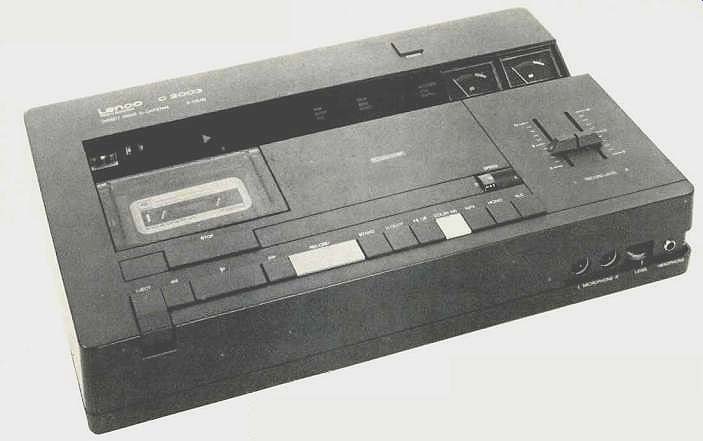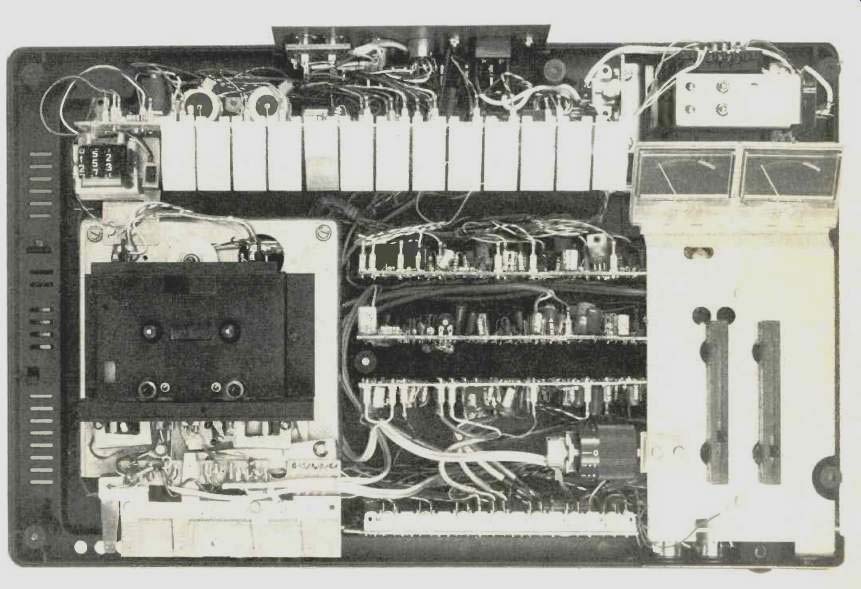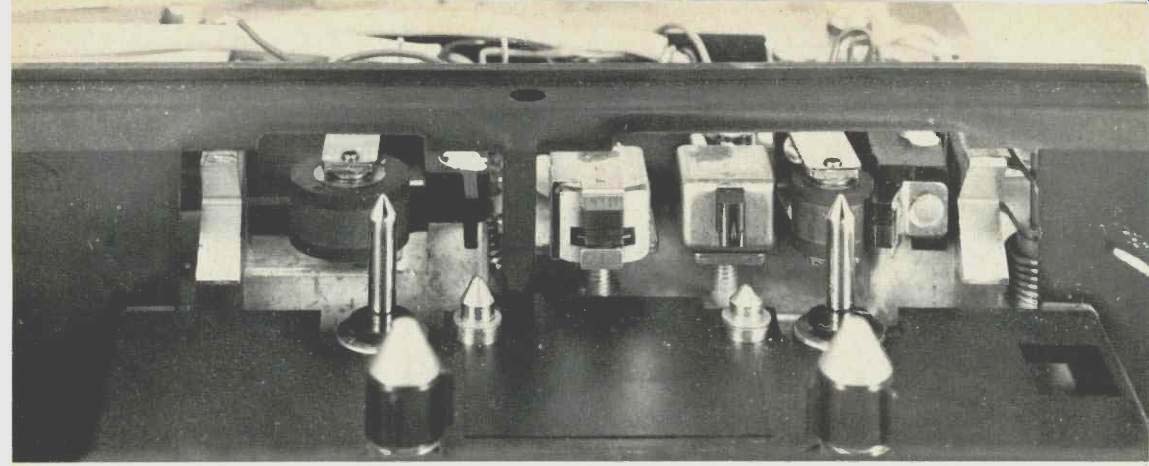
MANUFACTURER'S SPECIFICATIONS:
Motors: Two; one direct drive, servo controlled.
Wow & Flutter. 0.16 percent (DIN 44507).
Pitch Control: ± 2 percent.
Frequency Response: 30 Hz to 18 kHz, ±3 dB, with FeCr tape.
S/N Ratio: 56 dB, 65 dB with Dolby N/R.
Heads: Three.
Dimensions: 18 1/2 in. (47 cm) x 11 1/2 in. (29.2 cm) x 3 1/2 in. (8.9 cm).
Price: $795.95.
As we have mentioned before, European audio products do not always follow either American or Japanese designs, so most of them have a rather distinctive appearance and many of them offer something different in the way of features. The Lenco C2003, for example, has a variable speed control, two Dolby N/R sections, separate headphone level controls, pro vision for four different kinds of tape, and a radio input sock et. The DIN microphone connectors have a 5 volt d.c. supply -- useful if an electret microphone is used. Although it is a three-head machine, there is no monitor switch so if you want to make instant comparisons between the signals going into and coming from the tape, you have to use the switch on your preamp.

Fig. 1--Frequency response from a standard test tape.
Fig. 2--Record/replay response with BASF tape.

Fig. 3--Record/replay response with Scotch Master III FeCr tape.
Fig. 4--Record/replay response with Maxell UDXL-1 tape.
There are two motors, an a.c. servo-controlled type for the dual capstan drive and an asynchronous model for reeling.
Electronic interlocks ensure smooth operation and prevent tape breakages- just like the ones on those expensive open-reel recorders. Styling is predominantly black, presently very popular, though the deck is top loading which bucks the trend towards front-loading machines. A folding stand permits the deck to be placed at an angle that some people might find more convenient. The VU meters are mounted on an angled plastic panel, which extends almost the full width of the deck, with the remaining space being used to display the illuminated function and tape type symbols such as Record, Fast Wind, Dolby N/R, High Output Tape, etc.
On the front of the deck is a long row of piano keys ... the first four control the Eject function and the tape transport, while the next one, a large red bar, is the Record key. Then come three for tape selection ... a yellow key for Dolby, followed by keys for the MPX filter, Mono, and ALC (Automatic Level Control). A large Stop bar is located behind the transport keys, just in front of the tape compartment, behind which, at the rear on the plastic panel, is a digital counter with memory switch. Two record input slide controls are positioned at the right in front of the VU meters, and just to the left of them is a drum-type control for pitch or speed. On the extreme right on the front panel is the headphone jack with twin thumbwheel level controls and two DIN sockets for microphones.
The power On/Off switch is behind the VU meters, and the line input and output sockets are at the rear, together with DIN sockets for radio input and a remote control unit.
Also at the rear is an a.c. input socket--a suitable lead with plug comes with the deck.
The three kinds of tape matching selected by keys are:
Standard, High Output, and FerriChrome; while the fourth, CrO2 is switched automatically by the cassette and the words "Chrom Dioxyd Tape" appear on the display.
Performance
Tested with a standard test tape, the frequency response was within 2 dB from 40 Hz to 10 kHz as shown in Fig. 1. As BASF tapes were specified, a BASF Studio 90 was used for the first record/replay tests with the results shown in Fig. 2. It will be seen that the 0 VU response is fairly typical, but the -20 dB curve is somewhat unusual as it falls slightly from 9 kHz, rising again to 0 VU at 20 kHz with the -3 dB point at an amazing 25 kHz! Next a Scotch Master Ill ferrichrome tape was tried with similar results (see Fig. 3). Finally, Maxell UDXL-1, UDXL-11, and TDK Audua tapes were tested, and they all showed a frequency rise of +2 dB from 5 to 12 kHz, although the upper 3 dB frequency was still extended. Figure 4 indicates the results with Maxell UDXL-1, but the others mentioned within 0.5 dB of these curves.

------------Top, inside view

----------- Tape heads and transport mech.
Distortion at 1 kHz can be seen for the three tapes in Fig. 5.
The TDK Audua and Maxell UDXL-1 have the greatest headroom - 8.3 dB against 7 dB for the Scotch Master Ill Ferri-chrome and 6 dB for the BASF Studio, so the differences were not that great. Distortion versus frequency is shown in Fig. 6, and the BASF and Scotch Master Ill Ferrichrome were almost identical with the UDXL-1, and the TDK Audua was also quite close. In terms of signal-to-noise ratio, the BASF Studio and Maxell UDXL-1 tied at 59 dB, with the Scotch Master and the TDK Audua not far behind at 58 dB (all "A" weighting, referred to 3 percent THD, as measured). Switching in the Dolby N/R system improved these figures by approximately 9 dB. Incidentally, the Dolby level on this machine is 0 VU on the meters, not at the more usual +3 dB. As there are separate Dolby recording and playback sections, calibration is not 4 a problem and I found tracking to be within 1.5 dB down to -40 dB using the BASF Studio tape. Input required for 0 VU was 32 mV line and 300 pV for the microphone. Connecting a microphone did not affect the signal-to-noise ratio more than 5 dB. Input required at the radio input was 12 mV, and signal to noise was not increased as the signal is taken to the line amplifier. Output with a 0-VU input varied from 600 to 670 mV, depending upon the kind of tape used. Switching in the ALC brought the 0-VU sine-wave signal down to-4 dB and introduced some compression that was noticeable at the higher inputs.
Operation of the MPX filter produced a cut of 1 dB at 15 kHz with the-3 dB point at 16.5 kHz and an attenuation of more than 20 dB at 19 kHz.
Erase measured over 60 dB with the FeCr tape. Although the specifications claim 62 dB, the figure is quite good. Wow & flutter came out at 0.09 percent (DIN 45-507), and the possible speed variation, in playback only, was +3 and-2 percent. As the drive motor is servo-controlled, speed remains constant and unaffected even by fairly wide power line variations.

Fig. 5--Distortion at 1 kHz.
Fig. 6--Distortion vs. frequency
Listening & Use Tests
As mentioned above, there is no monitor switch on the deck, and the signal at the headphone and output sockets comes directly from the tape. Thus, in order to make comparisons, the output from the deck has to be connected to the preamp, or receiver, so a tape monitor switch can perform this function. Alternatively, headphones can be used for monitoring, but in any case there will be a slight time delay between the two signals corresponding to the distance be tween the record and playback heads.
In order to set the input levels, a slight touch on the Record bar switches on the electronics, and after adjusting the input sliders, the tape transport is activated by another touch on the Record bar while depressing the Playback key.
All of these functions are clearly displayed on the rear panel which makes the Lenco C2003 one of the easiest decks to use. In fact, if the ALC key is depressed, there is no need to touch the input controls as the levels are set automatically.
Because of the electronic interlock controls, it is possible to go from one tape mode to another without pressing the Stop key first- something you cannot do with most cassette decks.
As far as the basic performance is concerned, the figures speak for themselves. The frequency response is extended at both ends of the scale with low distortion, while the signal to-noise ratio is excellent. On the mechanical side, it is a beautifully made deck with Swiss precision throughout.
In summation, the Lenco C2003 is a fine cassette deck with many outstanding features that more than compensate for the possible inconvenience involved in the lack of monitoring. A final word of praise for the instruction book which is unusually detailed and written in seven languages.
--George W. Tillett
(Audio magazine, Nov, 1978)
Also see:
JVC Model KD-85 Stereo Cassette Deck (Nov. 1978)
Akai PRO-1000 tape deck (Nov. 1978)
Lenco Variable-Speed Turntable, Model L-75 (Jul. 1972)
= = = =